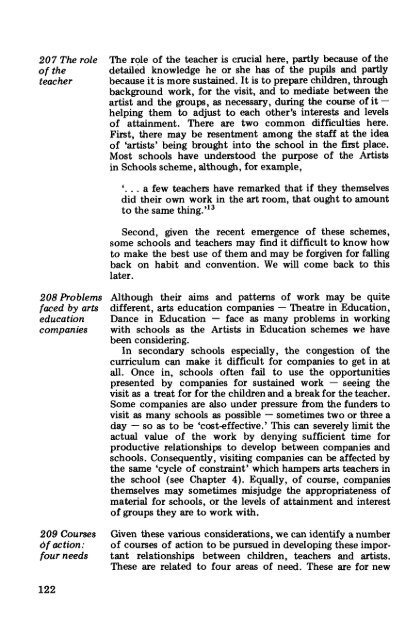The Arts in Schools - Calouste Gulbenkian Foundation
The Arts in Schools - Calouste Gulbenkian Foundation
The Arts in Schools - Calouste Gulbenkian Foundation
- No tags were found...
You also want an ePaper? Increase the reach of your titles
YUMPU automatically turns print PDFs into web optimized ePapers that Google loves.
207 <strong>The</strong> role <strong>The</strong> rple of the teacher is crucial here, partly because of theof the detailed knowledge he or she has of the pupils and partlyteacher because it is more susta<strong>in</strong>ed. It is to prepare children, throughbackground work, for the visit, and to mediate between theartist and the groups, as necessary, dur<strong>in</strong>g the course of it —help<strong>in</strong>g them to adjust to each other's <strong>in</strong>terests and levelsof atta<strong>in</strong>ment. <strong>The</strong>re are two common difficulties here.First, there may be resentment among the staff at the ideaof 'artists' be<strong>in</strong>g brought <strong>in</strong>to the school <strong>in</strong> the first place.Most schools have understood the purpose of the Artists<strong>in</strong> <strong>Schools</strong> scheme, although, for example,'. . . a few teachers have remarked that if they themselvesdid their own work <strong>in</strong> the art room, that ought to amountto the same th<strong>in</strong>g.' 13Second, given the recent emergence of these schemes,some schools and teachers may f<strong>in</strong>d it difficult to know howto make the best use of them and may be forgiven for fall<strong>in</strong>gback on habit and convention. We will come back to thislater.208 Problems Although their aims and patterns of work may be quitefaced by arts different, arts education companies — <strong>The</strong>atre <strong>in</strong> Education,education Dance <strong>in</strong> Education — face as many problems <strong>in</strong> work<strong>in</strong>gcompanies with schools as the Artists <strong>in</strong> Education schemes we havebeen consider<strong>in</strong>g.In secondary schools especially, the congestion of thecurriculum can make it difficult for companies to get <strong>in</strong> atall. Once <strong>in</strong>, schools often fail to use the opportunitiespresented by companies for susta<strong>in</strong>ed work — see<strong>in</strong>g thevisit as a treat for for the children and a break for the teacher.Some companies are also under pressure from the funders tovisit as many schools as possible — sometimes two or three aday — so as to be 'cost-effective.' This can severely limit theactual value of the work by deny<strong>in</strong>g sufficient time forproductive relationships to develop between companies andschools. Consequently, visit<strong>in</strong>g companies can be affected bythe same 'cycle of constra<strong>in</strong>t" which hampers arts teachers <strong>in</strong>the school (see Chapter 4). Equally, of course, companiesthemselves may sometimes misjudge the appropriateness ofmaterial for schools, or the levels of atta<strong>in</strong>ment and <strong>in</strong>terestof groups they are to work with.209 Courses Given these various considerations, we can identify a numberof action: of courses of action to be pursued <strong>in</strong> develop<strong>in</strong>g these imporfourneeds tant relationships between children, teachers and artists.<strong>The</strong>se are related to four areas of need. <strong>The</strong>se are for new122
















